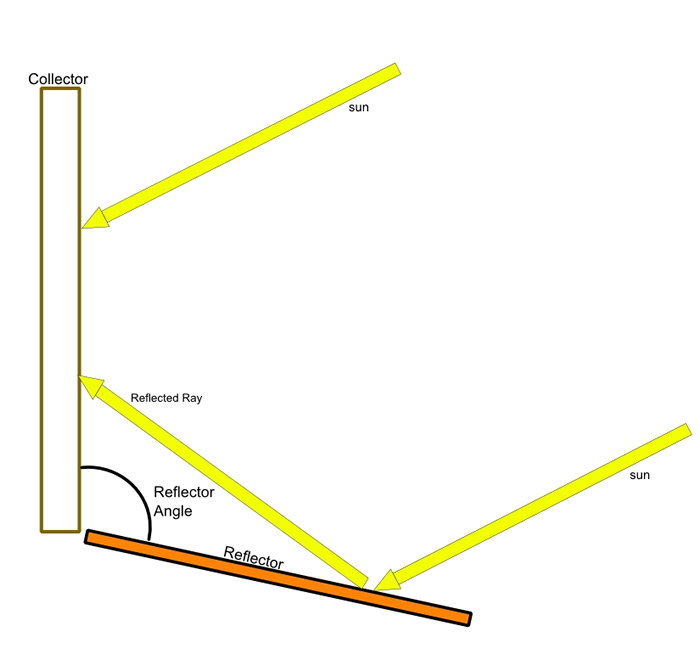
Search
The Renewable Energy site for Do-It-Yourselfers
Benefit of a Horizontal Reflector
for a Vertical Solar Collector
This section shows the benefit by season of a reflector placed below and extending outward from a vertical solar collector or window.
This material was developed by M. Steven Baker, University of Oregon in 1977, and is also appears in Edward Mazria's excellent book: The Passive Solar Energy Book, Expanded Professional Edition.
The three tables below show the benefit of a roughly horizontal reflector placed
in front of and below a vertical south facing flat collector or window.
The tables
cover the following design variables:
- Length of the reflector
- Angle the reflector makes with the window or collector
- Month of the year
- Location (latitude)
This diagram shows the setup.
The collector is vertical (e.g. flush to a wall), and the reflector is mounted at the bottom of the collector and extends out nearly perpendicular to the wall.
As the tables show, the angle that the reflector makes with the collector has a significant impact on the improvement that the reflector brings, and optimal angle varies with season.

The angle between collector and reflector (see diagram) is important, and
varies with both location (latitude) and the season of the year. For
example, for 40 degree latitude in July, the best angle is about 90 degrees,
and falls off rapidly as the reflector is tilted down further. For January
angles between 90 and 100 degrees give about the same improvement.
The improvement usually (but not always) increases as the reflector length increases depending on
season. The amount of extra benefit you get for more length varies with
season -- for 40 degree latitude, the summer gain appears to be about 75% for
all lengths from 0.5H up to 1.5H. In the winter, the gain improves as the
reflector is lengthened -- starting at 22% for a reflector that is 0.5H long up
to 51% for a reflector that is 1.5H long.
The reflectance used in these tables is 0.8 -- so, a good reflector that is
kept clean may do somewhat better. The
spectral
reflectance of snow, water, and ice appear to up in this general area, so
having these materials in front of your collector may give about the the benefit
these tables show for a 90 degree angle.
The material I have does not indicate how wide the reflector is relative to
the collector, but it is probably the same width as the window or collector.
Making the reflector wider than the collector
might gain some additional benefit ...
As a general rule, reflectors are most effective on vertical collectors during the Sumer, late spring and early fall -- even for a modest sized collector, the gain can be in the 70% area. The reason for this is that while the high summer sun make a large incidence angle on the vertical collector, it strikes the reflector nearly perpendicular to it. In the winter, the gain is much less because the sun is low, and now the vertical collector is getting the nearly perpendicular incidence while the reflector has a very large incidence angle. While the reflectors are most effective in the summer, there is still a good gain in spring and fall.
If anyone know how I can obtain a copy of the original publication by Baker, please let me know.
Table 1: Reflector half as long as collector:

Table 2: Reflector same length as collector:

Table 3: Reflector 1.5 times as long as collector:

For example: You are located at 45 degrees north latitude, and have wall mounted 100 sq ft collector that is 8 ft high and 10 ft wide. If you build a reflector that is full width (10 ft) and extends out 4 ft from the base of the collector, 1) what is the percentage gain that can be achieved in May and in January? 2) what is the optimal angle between the collector and the reflector?
Using the "Reflector Length = 1/2 Collector Height" table and the 44 degree latitude table section:
For May, the solar radiation gain is 74% if the collector to reflector angle is 90 degrees, 26% if 95 degrees.
For January, the solar radiation gain is 14% if the collector to reflector angle is 90 degrees, 17% if 95 degrees.
So, as expected, the gains in mid winter are worthwhile but modest, but the gains in spring (when the collector output is falling off because the sun is getting higher in the sky) the gains are considerable.
A reflector in which the collector to reflector angle could be adjusted over a few degrees would allow the angle to be changed seasonally to get the best gain in all seasons.
These gains are for an 80% reflective surface, so a good reflector that is kept clean will likely do better.
Again, these gains in solar radiation on the collector are achieved without increasing the collector heat loss, so you not only get the benefit of the gain, but also an improvement in collector efficiency.
Gary June 6, 2013




